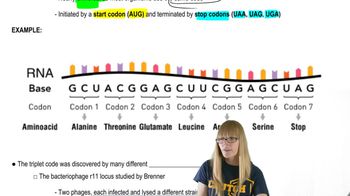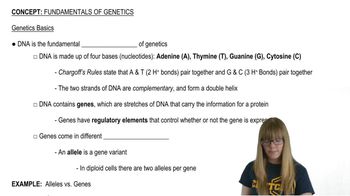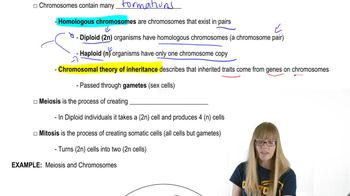Table of contents
- 1. Introduction to Genetics51m
- 2. Mendel's Laws of Inheritance3h 37m
- 3. Extensions to Mendelian Inheritance2h 41m
- 4. Genetic Mapping and Linkage2h 28m
- 5. Genetics of Bacteria and Viruses1h 21m
- 6. Chromosomal Variation1h 48m
- 7. DNA and Chromosome Structure56m
- 8. DNA Replication1h 10m
- 9. Mitosis and Meiosis1h 34m
- 10. Transcription1h 0m
- 11. Translation58m
- 12. Gene Regulation in Prokaryotes1h 19m
- 13. Gene Regulation in Eukaryotes44m
- 14. Genetic Control of Development44m
- 15. Genomes and Genomics1h 50m
- 16. Transposable Elements47m
- 17. Mutation, Repair, and Recombination1h 6m
- 18. Molecular Genetic Tools19m
- 19. Cancer Genetics29m
- 20. Quantitative Genetics1h 26m
- 21. Population Genetics50m
- 22. Evolutionary Genetics29m
1. Introduction to Genetics
Fundamentals of Genetics
Problem 7
Textbook Question
How is genetic information encoded in a DNA molecule?
 Verified step by step guidance
Verified step by step guidance1
DNA, or deoxyribonucleic acid, is composed of two long strands that form a double helix structure. Each strand is made up of a sequence of nucleotides.
Each nucleotide consists of three components: a phosphate group, a deoxyribose sugar, and a nitrogenous base. The nitrogenous bases are adenine (A), thymine (T), cytosine (C), and guanine (G).
The sequence of these nitrogenous bases along the DNA strand encodes genetic information. This sequence is analogous to letters in a language, where different sequences can represent different instructions or information.
The two strands of DNA are complementary, meaning that adenine on one strand pairs with thymine on the other strand, and cytosine pairs with guanine. This complementary base pairing is crucial for DNA replication and function.
Genetic information is read in sets of three bases, known as codons, during the process of transcription and translation. Each codon specifies a particular amino acid, which are the building blocks of proteins, thus determining the structure and function of an organism.
Recommended similar problem, with video answer:
 Verified Solution
Verified SolutionThis video solution was recommended by our tutors as helpful for the problem above
Video duration:
1mPlay a video:
Was this helpful?
Key Concepts
Here are the essential concepts you must grasp in order to answer the question correctly.
DNA Structure
DNA, or deoxyribonucleic acid, is a double helix composed of nucleotides, each containing a sugar, a phosphate group, and a nitrogenous base. The sequence of these bases (adenine, thymine, cytosine, and guanine) encodes genetic information. The specific pairing of bases (A with T and C with G) allows for the stable storage and transmission of genetic data.
Recommended video:
Guided course

DNA Structure
Genetic Code
The genetic code is the set of rules by which information encoded in DNA is translated into proteins. It consists of codons, which are sequences of three nucleotides that correspond to specific amino acids. This code is universal among most organisms, highlighting the commonality of life and the fundamental processes of protein synthesis.
Recommended video:
Guided course

The Genetic Code
Transcription and Translation
Transcription and translation are the two key processes through which genetic information is expressed. During transcription, the DNA sequence is copied into messenger RNA (mRNA), which then exits the nucleus. In translation, ribosomes read the mRNA sequence and synthesize proteins by linking the appropriate amino acids together, following the instructions encoded in the genetic code.
Recommended video:
Guided course

Translation initiation

 8:55m
8:55mWatch next
Master Genetics Basics with a bite sized video explanation from Kylia Goodner
Start learning



